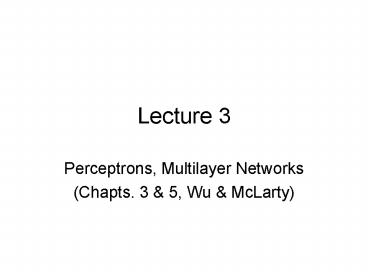Perceptrons, Multilayer Networks - PowerPoint PPT Presentation
1 / 18
Title:
Perceptrons, Multilayer Networks
Description:
Hidden layers are sandwiched between input and output layers. ... Take a look at the Smiley face and Splat programs. Try them out if you wish. GUI Elements ... – PowerPoint PPT presentation
Number of Views:42
Avg rating:3.0/5.0
Title: Perceptrons, Multilayer Networks
1
Lecture 3
- Perceptrons, Multilayer Networks
- (Chapts. 3 5, Wu McLarty)
2
Multilayer networks
- Perceptrons are restricted to data sets which are
linearly separable. - For this class of data, a perceptron can be
trained with a finite number of iterations - Multilayer neural networks include multiple
layers of neurons. - Hidden layers are sandwiched between input and
output layers. - Usually feature full connectivity between layers
- typically hundreds of connections, each with
its own weight. - Multilayer networks can be trained to implement
target functions which define surfaces in the
descriptor space.
3
A multilayer network
hercules.ece.utexas.edu/course/
ee380l/1999sp/present/pholsiri.ppt
4
Multilayer Terminology
- Often called a feed-forward network, since
signals flow in only one direction (toward the
output layer) - The first layer really serves to distribute the
inputs to the neurons of the hidden layer this
is done passively, with no application of a
transfer function. - Some disagreement in the literature as to whether
or not to include the input layer in the count of
layers.
5
Signal propagation in a three (two?) layer network
h1
W11o
W11h
xi
Ok
OM
xN
WDMo
WNDh
hD
6
Computing outputs
Transfer function
Hidden layer output
Output layer (target function)
7
Learning in multilayers
Minimize an error function
Find weights between layers so that
Where p h or o, and r and s take on all
appropriate values for each layer.
8
Backpropagation
- Calculating the weights needed to locate a
stationary position (all derivatives 0) entails
some sort of minimization procedure. - The most popular method (due to Rumelhart) is
called backpropagation. - Intuitively, the method adjusts synaptic weights
by propagating errors backward, from output to
inputs, and using the back-propagated errors to
adjust weights. - It has a rigorous foundation based on the
treatment shown in the previous slide.
9
BP Algorithm
For output unit,
Adjust weights to output unit
For hidden unit,
Adjust weights to hidden unit
10
BP Details
- Different algorithms exist for batch and on-line
training. - The derivation requires that the transfer
function (phi) be continuous step functions are
not allowed when using BP or similar training
methods. - The BP algorithm is not guaranteed to converge,
and if it does converge there is no lower limit
on the rate.
11
More Details
- Usually, one hidden layer is sufficient to model
a complex target function however, the number of
hidden units is an open question. - The sizes of the input and output layers are
generally determined by the problem statement
the number of hidden units is determined
heuristically. - In most topologies, the network is fully
connected (every output of layer j is connected
to every input of j1).
12
Building Java Classes
- Chapter 4
- Lewis Loftus
13
Custom Classes
- We will first work through the example in Listing
4.1, where we build a custom class to represent a
die (as in one member of a pair of dice). - Distinguish between instance and class variables
public and private variables and methods. - Principle Object should be self-governing it
should be the only entity to modify its own data.
14
Methods Terminology
- Accessor method
- Accesses an instance or class variable
- Mutator method
- Modifys a class instance variable
- Parameters
- The arguments passed to a method distinguish
- Formal parameters
- Actual parameters/arguments
15
Constructor Methods
- Distinguished by having the same name as the
associated class. Constructors initialize
instances of a class. - Constructores must NOT have any return type, not
even void!
16
More graphics programs
- Take a look at the Smiley face and Splat
programs. Try them out if you wish.
17
GUI Elements
- Components - objects that have a graphical face
and can be drawn in a frame. - Events - objects that correspond to a user
action. A mouse click generates an event, as does
dragging the mouse - Listener - an object that can intercept and
evaluate events.
18
Simple GUIs
- We will examine the PushCounter and Fahrenheit
examples from the text (Listings 4.10-11 and
4.12-13) - These simple examples actually demonstrate most
of the principles you will need in your own
programming work in BI785.

















![Introduction to Artificial Neuron Networks [ANN] PowerPoint PPT Presentation](https://s3.amazonaws.com/images.powershow.com/6292342.th0.jpg?_=20150319091)













